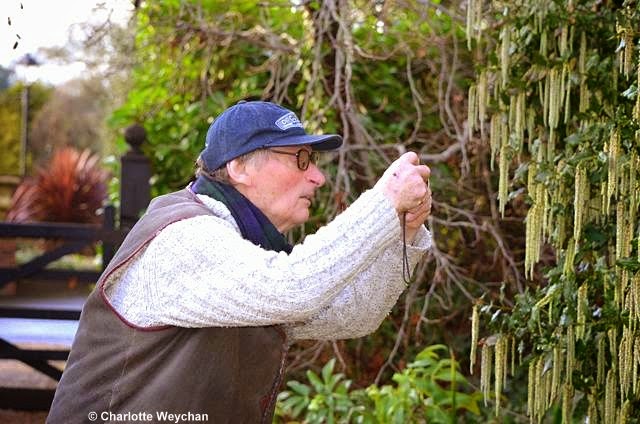A winter walk with John Brookes at Denmans and his thoughts on garden design
 |
| John Brookes, with his camera in the garden at Denmans today |
What better way to spend a Sunday that with my dear friend John Brookes in the garden he has created over the last 30 years - Denmans - looking at what's already in bloom? John is remarkable - at 81 he is still designing gardens, both here and overseas, and apart from his own plot, near Chichester in Sussex, is best known for the Chicago Botanical Garden and numerous private gardens around the world. While we walked around his four-acre garden, which is already beginning to bloom, John talked to me about his design philosophy.
 |
| John identified this as camellia "Adolphe Audusson" |
While chatting to John about his design work, he explained: "First of all, for smaller gardens, I work with the proportions of the house and evolve a module or a grid using those proportions. Then I determine the kind of pattern the garden needs, asking if it's symmetrical or asymmetric and then I start thinking about the work of the 20th century Modernist painters and reflect on their patterning techniques." John has become world-renowned through his work and the 24 books he has written to date, translated into many different languages, and there can be few of us in the gardening world who don't have a copy of one of them on our shelves. I certainly had John Brookes' books long before I was lucky enough to meet him in a garden he designed in Sussex. Our close friendship came later and as many readers know, he has been integral to my work in India over the years, and often travelled there with me.
 |
| Signs of life for the magnificent magnolia at Denmans |
John says: "I have recently discovered the work of the Russian painter, Malovitch, but have always been inspired by the work of painters closer to home - notably Piet Mondrian and Ben Nicholson. And while not slavishly copying their work, it inspires me to look at patterns and patterning that would be suitable for use outside. I was also interested in the work of the Brazilian, Roberto Burlo Marx and the Mexican, Luis Barragan. Marx was renowned for his organic-shaped gardens and Luis for colouring his various buildings and making them almost sculptural." But as John said: "This has nothing to do with horticulture, but everything to do with the building, which the garden is to surround, the clients who live in it and their age, and of course, the location."
As we walked around his own garden this afternoon, enjoying the watery sunlight and shivering slightly in the almost sub-zero temperatures, we were flanked by his two pugs (right). In between looking at the early flowering plants and shrubs at Denmans he explained the way he sees his work:
"It's so obvious to me, all those wonderful patterns that can be translated into garden design."
And when he has digested all this and decided how a garden will be laid out, planning areas of grass or water, then comes the planting, where he starts with what he calls his "skeleton plants, which work ultimately with the scale of the structure and the scale of the surround of the site."
"It goes without saying that the suitability of soil and location is also a prime consideration and of course what the client likes and dislikes."
"So I build up my garden design in these stages", said John, as he photographs some of the shrubs that are beginning to show signs of colour so early in the season here in the UK.
"And only when I am happy with my concept do I talk with my client and present it to them. But it's got to be said that I only work with hand-drawn plans, not computer programmes, because for me they are much more personal for the client. Many of the initial drawings which are not actually plans are presented as overlays on a site image and this helps the client to envisage the full potential of their site, whilst understanding the various stages involved in taking the plan from drawing board to planted project.
"When it comes to bigger gardens, this basic theory is applied to whatever scale of site I am asked to work on and simply by doubling or trebling the basic module or grid, I can work from the smaller scale of the house, through to the larger scale of the site and even its landscape beyond."
In bloom at Denmans today, we saw many camellias, Daphne odora, bountiful hellebores and the joyous beginning of spring as bulbs are starting to erupt from the frozen ground after so many months of winter. The weather forecast is for a further spell of very cold weather in the next week, so watch this space as I endeavour to catch frosty plants with my lens in the next few days.




Very interesting to hear about his design process! Considering the people I've met who I'd consider to be 'geniuses', I would say it is because of their ability to rapidly analyze patterns. I think this is true in many different fields, including garden designing. I marvel at the ability of people like Brookes who can see the garden in all its shapes and proportions and use such visual patterning to truly create artistic beauty.
ReplyDeleteSo good for me to take the time to read your blog today. I just spent part of the holidays at the Chicago Botanic Garden (in fact I have posted some photos from there that I took on this recent visit, you can find them in the January archive postings from earlier this month) What a treasured time to spend with sun a designer. That is special. Jack
ReplyDeleteCharlotte, you captured so much in this post. I remember you talking about Mr. Brookes. To see him in his garden is a real treat. I connect with the way he designs. It is familiar and I so agree about hand-drawing, for me it is a more fluid and organic way to capture my ideas on paper. I will go look for books he has written. I am so inspired. I am so happy you are friends. I love the way you made him smile as you photographed him. I think of you often since meeting in Portland.
ReplyDelete